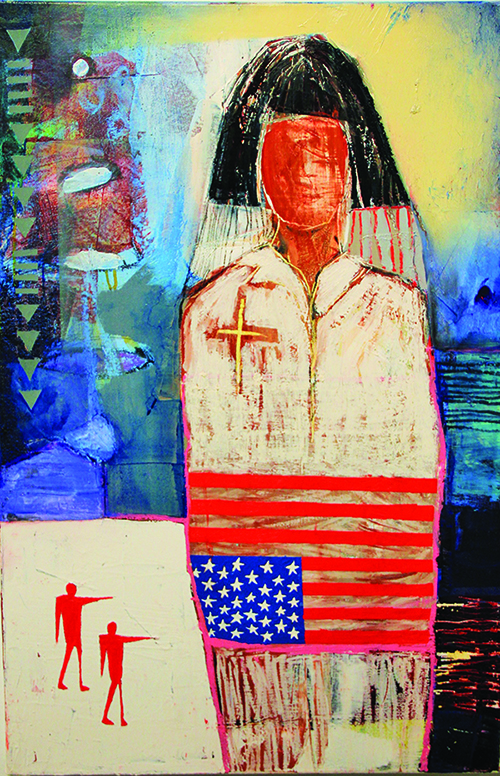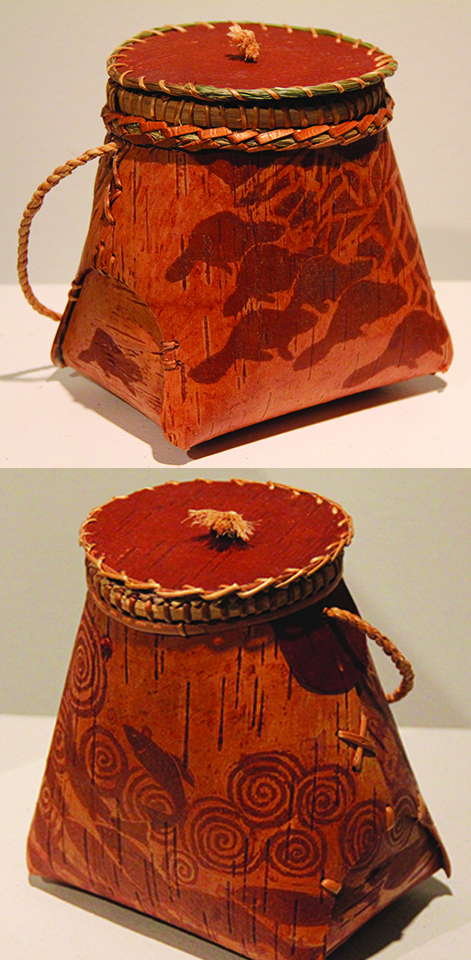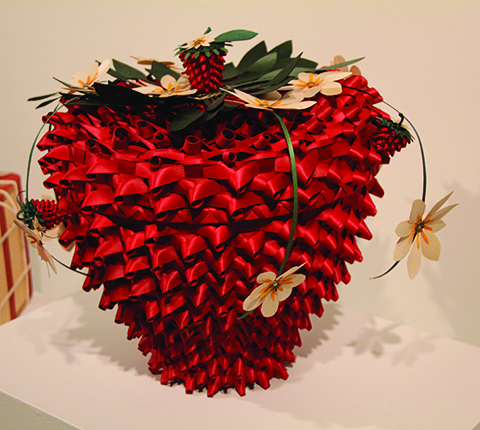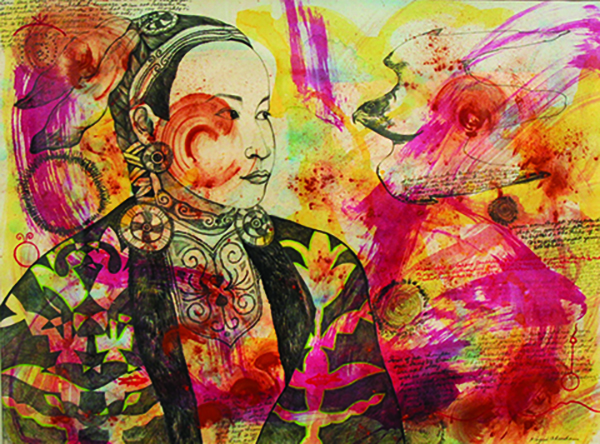
“Young Nation is a painting using direct visual symbolism to create dialogue about the attempted erasure of Indigenous cultures through forced assimilation by violent European colonization in the Americas (and abroad). American mythologies of ‘manifest destiny’, ‘frontier expansionism’ along with the use of Christianity’s land claims via papal bull’s like the Doctrine of Discovery were utilized to enact agendas such as: Indian Boarding Schools, Termination acts, Relocation acts, Reservations, land theft and biological warfare. This systemic and environmental racism is still happening across Indian Country today. Young Nation asks the questions: is forced colonization worth the attempted erasure and destruction of Indigenous culture, art & paradigm?
There is sadness and pain in recognizing the losses, but there is also an empowerment in acknowledging the injustice. When the dominant culture is unaware of the ugly horrors in our shared histories, such as the Indian Boarding schools whose motto was “Kill the Indian, Save the Man,” then I feel creating paintings that bring light to these cultural secrets are of the imperative.”
by Micheal Rios, Tulalip News
The House of Welcome Longhouse Education and Cultural Center located at Evergreen State College in Olympia is celebrating 20 years of groundbreaking work. Work that emphasizes promoting indigenous arts and cultures through education, cultural preservation, and creative expression. The House of Welcome celebrates the essence of that work with its latest exhibition, Building Upon the Past, Visioning Into the Future.
Curated by Longhouse staff members, Erin Genia (Sisseton-Wahpeton Oyate) and Linley Logan (Seneca), the exhibition features the works of artists from this land, local Squaxin Island, Skokomish, Puyallup and many other Salish tribes. Tribes from across the nation are also represented, from Alaska, the Plains, and across the Pacific Rim, including Kanaka Maoli artists from Hawaii and Maori artists from New Zealand.

Dawn Walden (Mackinac Band of Chippewa and Ottawa). Birch bark, cedar bark, cedar roots, sweetgrass, bass wood corded handle.
“Essense of Birch Tree. Though I consider myself a Contemporary Native Artist, I look for the sacred in form and traditional materials, blending contemporary with traditional weaving. For me it is about showing respect for the tradition and spirit of the materials, always seeking a balance between myself, the materials, and the form they are creating. There is a sense that I am imbuing admiration, respect and belonging to the solid form of the tree, plants and the artwork as well.
I would like the viewer to be removed from current time and space, and drawn into the work so they might experience what I have translated. It is no longer a thing, but a trigger for the expression of feeling.”
“This exhibition reflects the twenty years of building relationships with artists locally, regionally, nationally and internationally,” stated exhibition co-curator Erin Genia. “Native artists are using so many different methods for expressing themselves and we really wanted to display as many of those methods as possible. The result is we have close to ninety beautiful pieces of art, treasures really, that make up this exhibition.”
The subjects and techniques exhibited by the Longhouse artists draw from a diverse range of stylistic traditions, which arise from cultural teachings, ancestral lineages, and each artist’s unique experiences as indigenous peoples. Works on display include paintings, drums, carving, beadwork, photography, baskets, and jewelry.
“As a curator of this exhibition it’s such an awe-inspiring experience to hear from the artists themselves as to the perspective and inspiration behind their artwork,” added fellow co-curator Linley Logan. “We have artists who are very traditional and roots oriented; artists who use the natural resources around them to showcase their creativeness. In a contemporary lifestyle in nature, we’ve continued to use the resources around us which now include materials other than natural materials. We’ve come full circle in our intent to build upon the past and vision into the future creatively and intellectually as indigenous people.”



“I recognize that there are two cores of identity within me and at their fundamental, both have direct internal attachment to and beliefs in the land as a constant spiritual force. Indigenous people know things – the land gives authentic direction about how to live. The land can and will offer instructions about healing.
In my experience, I’ve consistently found that all of nature communicates concerning their healing properties, that lying directly next to the earth will comfort you and send love into your pain, that there is strengthening power in expressing gratitude, that self-forgiveness and forgiveness of others is about cleaning one’s own soul. Lately, I have added these: that love can and does heal anything and everything, that connecting to Creator/Source daily makes more love, clarity, and cleans the earth – and somehow helps ancestors who in turn are more available to assist.”
The exhibition was on display from March 31 – May 11. The House of Welcome was gracious to allow syəcəb staff a private tour of the exhibition so that we could share amazingly creative and exceptional Native art with our readers over the next couple issues.
